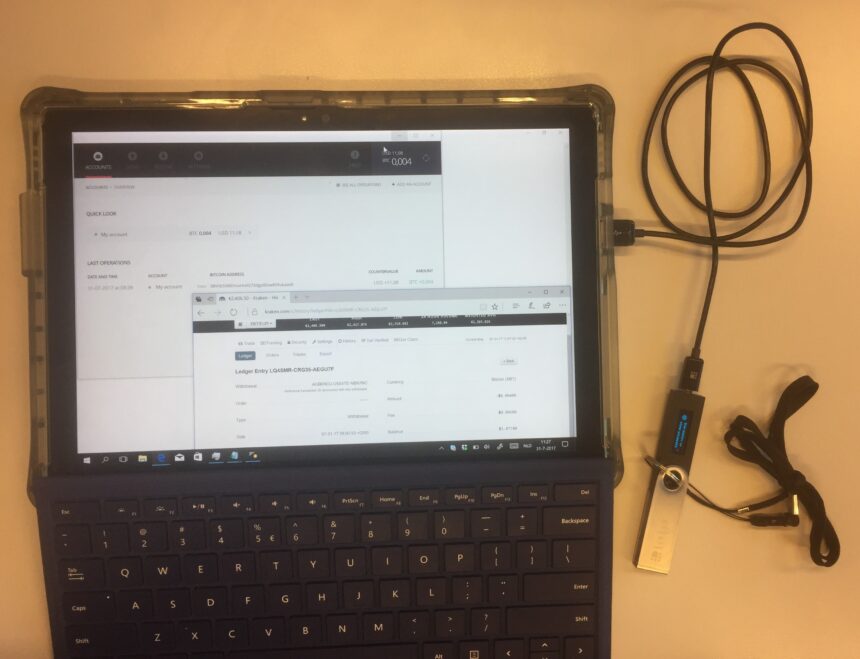You Can Find It In This Article
Blockchain nodes are an important part of the network. They act as participants that validate and relay transaction. They store the distributed ledger of the blockchain and verify that transactions are secure and legitimate. Nodes are important in the prevention of fraud by maintaining consensus on the network.
You can think of each node as a gatekeeper protecting the integrity and security of the blockchain. Together, they confirm the transactions and ensure that each entry in the ledger are accurate. The decentralized nature would be compromised without nodes. This highlights their significance in the innovative technology.
Understanding blockchain nodes can provide insights on how the system works and why it is so reliable. The more a person explores the topic, they will realize that nodes aren’t just technical elements; they are essential to secure digital transactions in the future.
Understanding Blockchain Basics
The blockchain technology relies on key concepts to enhance its functionality and value. This section explores decentralization and its importance, as well as the role nodes have within a network.
Blockchain Definition
Blockchain is a ledger digital that tracks transactions on many computers. Every transaction is organized into blocks. The blocks of data are linked in chronological order, forming a chain. It is nearly impossible to change any data in a single block without also changing the subsequent blocks. Every node on the network has a copy the blockchain to ensure transparency and security.
The Importance Of Decentralization
Blockchain technology is fundamentally decentralized. Multiple nodes take on the responsibility of data instead of one central authority. This increases data security, and reduces risk. The network is resilient if one node goes down. The users can trust the fact that there is no way for a single entity to manipulate the information as multiple nodes are required to make any changes.
Nodes are important in blockchain
The backbone of any blockchain network is the nodes. Every node is a participant in the network, maintaining its own copy of blockchains and validating transactions. Nodes collaborate to verify a block before adding it to the blockchain. The process is designed to ensure accuracy and reduce fraud.
They also exchange information with each other to spread it across the entire network. Users can interact with the Blockchain, either for data or transactions. Nodes ensure the security and integrity of the system by decentralizing the control.
There are different types of blockchain nodes
The blockchain nodes form the core of any decentralized network. The blockchain is operated by each type of node. Each has its own functions and responsibilities. It is important to understand these types in order to grasp the functionality of blockchain.
Full Nodes
The full node is the spine of the blockchain. These full nodes maintain an exact copy of the entire blockchain, and they validate transactions according to network rules. The verification process is time-consuming and requires a lot of storage space.
Two main types of nodes are available: archived and pruned.
-
Full Nodes pruned: These full nodes only download and store a small amount of history, but they keep all recent transactions. These nodes free up space while contributing to the security of the network.
-
These nodes, on the other hand, store all of blockchain history indefinitely. These nodes are essential for developers that need full access to the blockchain for building or analysing applications.
The network will run smoothly with both types.
Light Nodes
Users with limited resources can benefit from light nodes. They do not have a full copy of the Blockchain. Light nodes instead download only part of the blockchain. This is usually the block headers.
Light nodes are reliant on full nodes to verify transactions.
-
The smaller size and lower bandwidth makes them perfect for mobile devices.
-
Speed: The light nodes are able to verify transactions quickly, which allows for a faster interaction with the blockchain.
These nodes are essential, particularly for those users that want to quickly access the blockchain but don’t need the extra overhead associated with a complete node.
Authority Nodes
The authority nodes provide an extra layer of structure for blockchain networks. These nodes play an important role in the block validation process and governance.
-
They are usually part of permissioned blockchains. To participate, they must fulfill certain criteria such as stakeholding or identity verification.
-
Authority nodes can be categorized into two types: masternodes and staking nodes. Users must lock cryptocurrency to staking nodes to provide security and stability for the network. Masternodes offer additional features, such as instant transactions and privacy.
The authority nodes maintain the order in the blockchain by ensuring only those participants who are trusted can validate transactions.
Nodes have a function
The blockchain node is a key component of any blockchain system. It facilitates communication, validates transactions and maintains the integrity. These functions help explain why nodes play a crucial role in any blockchain.
Transmitting Information
The nodes are the communication hubs of the blockchain. The user broadcasts the transaction to nodes nearby. The nodes relay this information on to the other nodes in the network, creating an ongoing data flow.
Using this transmission, all nodes will receive the exact same information about pending transactions. Every node keeps a duplicate of the ledger that is updated as each transaction is validated. The constant communication prevents discrepancies, and all participants are kept informed.
In order to ensure efficient transmission, blocks of transactions must be propagated once they have been added to the network. It allows faster updates as well as real-time network synchronization.
Validation Process
Nodes check a broadcast transaction against rules in the blockchain. The nodes check if the details of the transaction meet the requirements. This includes verifying the digital signatures, and making sure the sender is able to pay. Nodes collaborate to verify transactions.
Each node then records the transaction into its own local copy of blockchain. It is important to maintain accuracy in order to prevent fraudulent transactions being added onto the blockchain.
Nodes will reject a transaction if it is invalid and stop it from affecting the integrity of the network. The validation process ensures that users are able to trust each other by processing only valid transactions.
Consensus Mechanism
Any blockchain network cannot function without consensus. Nodes rely on a variety of algorithms to agree upon the current state of the Blockchain. It is important to ensure that the blockchain contains all transactions.
For example, in proof-of work systems, nodes are competing to solve mathematical problems complex enough to add blocks. A node that successfully adds blocks broadcasts its updated ledger after adding a successful block. This addition is confirmed by other nodes, resulting in consensus.
Simpler systems such as Proof-of-Stake allow nodes to validate transactions by the amount of crypto they own. Every consensus mechanism is designed to protect the network from attacks, and make sure that every node has a uniform view of the Blockchain.
Node Requirements
To set up a node, you need to meet certain hardware, network, and software requirements. Knowing these requirements will help you choose the best setup to achieve optimal performance.
Hardware Specifications
Specifications for hardware can differ depending on the blockchain type. Nodes typically require:
-
Multi-core CPUs are recommended for handling multiple tasks.
-
For smooth performance, you will need at least 4GB or 8GB RAM.
-
Storage can vary from 100GB up to terabytes depending on the blockchain. SSDs are preferred to access data faster.
-
Data loss can be prevented by regularly backing up your data.
Since running a network continuously can produce heat, node operators must also take into consideration the cooling and power system.
Software Necessities
Software is essential for the security and functionality of a node. Node operators must install various components including:
-
Blockchain Client (also called Core Software): The core software for a blockchain, such as Bitcoin Core, Ethereum Core, etc.
-
Linux, Windows or macOS are the most common choices. Linux’s stability and security makes it a popular choice.
-
Firewalls and security software: It is essential to protect the network from threats externally. It is important to have a robust firewall.
-
Updating the software regularly ensures that the node is secure and runs optimally.
It is important to understand the software requirements for smooth operations.
Network Connectivity
For a node of the blockchain to work effectively, it is important that you have a reliable internet connection. The following are key aspects:
-
It is recommended to have a minimum bandwidth of 1Mbps for both downloads and uploads. For high transaction blockchains, higher speeds are preferred.
-
Low Latency Improves Communication with Other Nodes Ideal latency is below 100 milliseconds.
-
Port forwarding allows other devices to easily connect. It is essential to maintain network participation.
-
To contribute consistently, a node must have a high-uptime target, usually exceeding 95%.
The role of the node in the Blockchain ecosystem is dependent on a strong network connection.
Blockchain Transactions
In order to conduct blockchain transactions, data must be created, validated, and stored within the network. This ensures that the transactions are accurate and permanent.
Production and Broadcast
Each transaction starts with the user asking to send digital assets. The request will include key information such as the recipient’s name, address and amount. The transaction is then packaged as a “message” once the user has created it.
The message is broadcasted to all nodes in the network. The network nodes receive the message almost immediately. In this phase they play an important role, as the ensure transactions are shared and validated by other nodes.
Transaction Verification
The transaction is verified after broadcast. The nodes verify the validity of the transaction, checking that it is valid and the recipient has sufficient funds.
The blockchain protocol defines the rules for verification. The blockchain is checked by each node. The transaction will be accepted if the majority of nodes confirm that it is valid. It is then rejected if it does not.
Store in Blocks
Once transactions have been verified, they are then grouped together into blocks. The block is linked with the block before it. Every block is uniquely identified by a hash. This ensures the integrity of each block.
The block is then added to the Blockchain. This update is done by the entire network. It is nearly impossible to change past transactions.
Consensus Protocols
For a network of blockchain nodes to remain in agreement, consensus protocols are vital. These protocols ensure that everyone recognizes the same truth or state of the Blockchain. This section covers the key methods for reaching consensus.
Proof of work (PoW).
A consensus mechanism, Proof of Work (PoW), is commonly found in Blockchains such as Bitcoin. This system is a competition between nodes (also known as miners) to solve mathematically complex problems. The competition is a major computational challenge.
The miner receives cryptocurrency as a reward for solving the problem. The network is protected by this process, which makes it difficult for a single entity to take control.
The time needed to mine the blocks can slow down transaction speed and increase energy consumption. PoW has also an impact on centralization of mining, as only powerful hardware is able to compete.
Proof of Stake
Proof of stake is a new way to reach consensus. PoS relies on nodes to verify transactions, not on their computational power. Instead they are selected based on how many coins each of them has and is willing to “stake”, or lock.
The method allows for faster processing of transactions and lower energy consumption. A node can be penalized for dishonest behavior by losing a portion of the coins they stake. This discourages bad behaviour.
Ethereum is a popular coin that uses PoS after it transitioned from PoW. PoS is a network security solution that’s more eco-friendly than PoW.
Consensus methods
There are other mechanisms of consensus besides PoW and PoS. There are two consensus mechanisms: Delegated Proof of Stake and Practical Byzantine Fault Tolerance. DPoS is a method of increasing the efficiency by electing a few trusted nodes.
PBFT focuses primarily on achieving consensus within networks that have known participants. This can improve speed and security. Different methods offer unique advantages and difficulties, depending on the needs of each blockchain application.
Blockchain networks are able to optimize their performance and reliability while maintaining security by using a variety of consensus strategies.
Safety and privacy
Blockchain nodes are essential for ensuring security and privacy. These nodes ensure the safety of transactions and protection of sensitive data. The immutable ledger and the robust cryptographic techniques are key elements.
Immutable Ledger
Blockchain ledgers are designed to be unalterable. Once a transaction has been recorded, the record cannot be altered or removed. The immutability of the blockchain ledger builds trust between users and network participants. Each transaction links to its predecessor, forming a block chain. To change past transactions, all blocks would need to be altered. Due to its decentralized nature, this is almost impossible.
Resistant to Change
Every node in the network has a copy of the Blockchain. The system is more resistant to attack because of this redundancy. An attacker must control more than half of all nodes to manipulate the ledger. This is known as the 51% attack. This is very unlikely to happen in established networks due to the large number of nodes. Decentralization helps protect data from unauthorized modifications.
Blockchain Cryptography
The use of cryptography is essential to ensuring that blockchain transactions are secure and private. The data is difficult to decrypt without the right keys because each transaction uses advanced algorithms. Access to cryptocurrency is controlled by public and private keys. Hashing is another way to secure data by making it a string of a specific length. This ensures that any changes will be visible. The strong cryptographic system protects users’ identities and prevents fraud.
Mining and Staking Nodes
Nodes that mine and stake are crucial to the security of blockchain networks. These nodes help to maintain the integrity of the network and verify transactions. Participants are motivated by different methods of both processes.
Mining Process
Computers are used to solve difficult mathematical problems. Mining is a competition between miners to add blocks to blockchain. Proof of Work is the name of this process. The block reward is usually cryptocurrency.
The miners must also verify transactions that are contained within a block. In order to do so, they need to verify that the user has enough coins in their wallet for transactions. This is often done by full nodes, who store the blockchain in its entirety and ensure the accuracy of every block. The network is more secure and reliable because of this collective effort.
The Consensus Stakeout
Staking is an alternative approach for maintaining blockchains, which is commonly used by networks operating on Proof of Stake. Participants lock up cryptocurrency instead of mining to verify transactions.
The amount of crypto they own and the willingness to stake is used to select those who will add blocks. The energy required for mining is reduced by this process. This encourages the holders to maintain their assets within the network and promotes stability.
Reward and incentives
Participants receive rewards both for mining and stake. The mining rewards include new coins and transaction fees, which encourages competition between miners.
The rewards for staking are usually transaction fees, but also newly-minted coins. More coins you stake, the greater your chances of getting chosen as a validator for a block. The incentives encourage participation, and improve the security of the network.
Nodes and Economic Impact
The role of nodes in blockchain networks is significant. These nodes are expensive to operate, but they also have the potential to generate income through mining or staking. These two factors can have a significant impact on the sustainability and profitability of a blockchain.
Costs of Node Operations
Operating a node blockchain involves a variety of costs. Hardware expenses are included, like purchasing a computer or server that is reliable. The blockchain data can also grow in size over time, so nodes need enough storage.
Another major cost is energy consumption. Nodes use electricity to operate, particularly full nodes that are constantly in sync with the system.
Joining a pool of miners can often help spread these costs across multiple participants. The operation of the nodes becomes more affordable for miners, who may struggle to afford the costs associated with mining alone.
Mining and Staking Revenue
Blockchain networks offer financial incentives to nodes via mining and stake rewards.
The mining nodes are rewarded for adding new blocks and validating transactions to the blockchain. The network reward structure, coin price and the mining node’s performance can all lead to significant profits.
Proof-of-stake rewards stake nodes for their participation. They help maintain the integrity of the network by locking their coins into it.
The revenue generated by a node can be derived from both methods. Profitability can vary depending on the market, the energy cost, and how competitive the network is.
It is important for anyone considering joining a blockchain network to understand the economic implications.
FAQs
What types of nodes are there in the blockchain?
Each type of node has a distinct role. Full nodes are the most common, followed by light nodes and mining nodes. Full nodes maintain a copy of the entire blockchain, and they verify all transactions. Light nodes only store a part of the Blockchain, and rely on full nodes to provide information. Mining nodes add transactions to the blockchain and validate them.
What is the blockchain’s validation process?
Blockchain nodes verify transactions using a consensus system. The transactions are compared to the blockchain data. Nodes verify that a transaction adheres to network rules such as spending the coin only once. Nodes will propagate the valid transaction across the entire network if it is valid.
What role does a node play in cryptocurrency networks
The mining nodes are crucial to cryptocurrency networks. The mining nodes validate new transactions and add them to the blockchain. Proof-of-work is a process that involves the solving of complex mathematical problems. Mining successfully rewards nodes in cryptocurrency and encourages them to participate in the network.
How can operating a node on the blockchain be profitable?
Depending on a number of factors, operating a Blockchain node may be profitable. Success for mining nodes depends on the ability to solve blocks and earn rewards. Nodes can be full or partial, and they do not earn any money directly. However, their role is to support the network by facilitating transactions. Running a node can sometimes provide you with access to network incentives and stake rewards.
What is the minimum requirement for running a blockchain full node?
A full-fledged blockchain node is run by a combination of hardware and software. A powerful computer, with enough storage and memory, as well as a stable internet connection, is usually required. The user must download and install all the blockchain software in order to save the complete blockchain ledger. The specific requirements for each cryptocurrency may differ.
What is the effect of the location on a node’s performance?
Location of the blockchain node may affect its speed and performance. Communication times may be faster for nodes located nearer to network participants. For efficient data transfer, a stable internet connection with a high speed is essential. Latency can be affected by geographic location, and this affects confirmation time.






